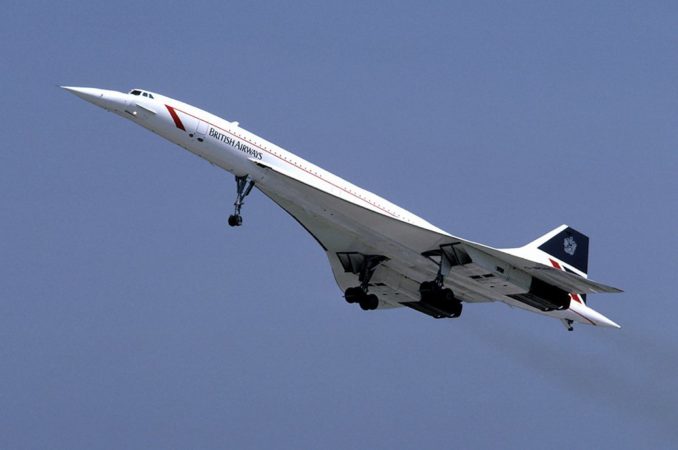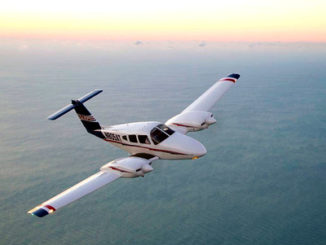
Eduard Marmet [CC BY-SA 3.0 GFDL]
Initial thoughts of such transport were started in the 1950’s, focusing around the required wing shape necessary for both supersonic flight and low speed manoeuvrability, but it wasn’t until the Anglo-French accord of 1960 that work began in earnest. Wikipedia suggests that the British plans were leaked to the French who then claimed them as their own.The design chose a maximum of Mach2 to allow the use of an Aluminium airframe – any higher speeds and the temperatures involved would have meant the metal softening. Even with the restricted speed, the aircraft would stretch by 8 to 11 inches as the skin reached 125degC, despite an outside air temperature at 60000ft of -40c.The engines chosen, Rolls Royce Olympus 593-610 were already in use on the Vulcan bomber and further developed for the TSR2. Producing 11,000lbs thrust for Vulcans, they were uprated and improved, with the final versions producing 33,000lbs thrust at full power or up to 38,000lbs with reheat. To give some idea of the power, the most recent HMS Ark Royal also had 4 Olympus engines, producing a total of 97000lbs of thrust to move and power 22,000 tons. Concorde’s engines produced a total of 152,000lbs to move a maximum take-off weight of 186 tons. It was thirsty, each engine using 2885 gallons of fuel per hour. With a maximum 96 tons on board meaning range was limited to 4480 miles.
The fuel crisis of the 70s hit just as the aircraft companies were taking orders for production and the high fuel cost, 17mpg per passenger, meant orders dried up. In the end only 20 were built. Two prototypes, two pre-production prototypes and sixteen production airframes. Of the production aircraft seven were delivered to British Airways, seven to Air France with the remaining two retained by the manufacturers, later to be used as a source of spares.

Christian Kath [CC BY-SA]
Many technical challenges led to world firsts – the variable engine intakes had to slow the airflow to sub-sonic speeds to prevent the engines being blown out, and were controlled using electronics – the first use of a digital control system. Stepping into the cockpit you walk through a tunnel of fuses and transistors – there are no silicon chips, each of the seven computers on board were transistor based.
The additional flying altitude gave additional challenges; the aircraft was the only one with a cosmic radiation monitor to monitor for solar flare activity, the plan being to descend to more shielded altitudes if there was a burst of solar radiation. In the end the buzzer only went off once in service, and was later found to be a false alarm.
Traffic would not normally be a problem at that altitude, but Concorde did on one occasion have to request a US Airforce SR-71 Blackbird spy plane to alter course to avoid problems. The US crew remarked at being rather envious of the 100 passengers sitting in shirt sleeves having breakfast while they were in full pressure suits, similar to astronauts.
Timetabling and flight planning systems had to be significantly altered, not least as the schedule for London to New York would involve take off at 10am and landing at 9am, the flight having been faster than the rotation of the earth. Naturally cabin crew were granted two breakfast allowances on such flights. The flight planning system was amended to display speeds in Mach rather than Mph.
There are many world records associated with Concorde – the expected ones such as most hours flown supersonically by any aircraft type, fastest commercial flight over the Atlantic (2hrs 53mins – LHR – JFK). Even as it was decommissioned it was breaking records, with the final flight of G-BOAG setting the record for New York to Seattle of 3 hours 55 minutes.
The longest golfing putt of 9.2miles was achieved by Jose Maria Olazabal when taking the traditional Concorde charter to the Ryder cup in 1999, by putting up the aisle while at Mach 2. The putt of 150 yards up the cabin took 26 seconds while Concorde travelled the 9.2 miles.

Plismo [CC BY-SA]
Why was Concorde so loved? It showed Britain what it could do with significant resources, in the time before computer aided design, producing something of real beauty in form and function. The final retirement was down to two factors, firstly the 9/11 tragedy removing the confidence of many of the customer base to justify such an expensive way to travel – it was rumoured to need around 22 full fare passengers per flight to break even. Secondly the prohibitive cost of spare parts as the manufacturers retired the experienced staff and machine tools, e.g. the rudder costing £200k.
There is talk of restoring an aircraft, and funding is said to be in place. The airframe itself was only halfway through the permitted lifespan, so well cared for examples should have few technical problems to fly, though I doubt if it will be allowed to take fare paying passengers again. Originally it was expected the aircraft would be in service until around 2018. Hopefully 2017 will see one airframe, sadly a French one, in the air once more.
Sources: BA Engineering Visitor escort guide, Wikipedia and legend/folklore I remember from the past.
© Sweaty Dave 2016



